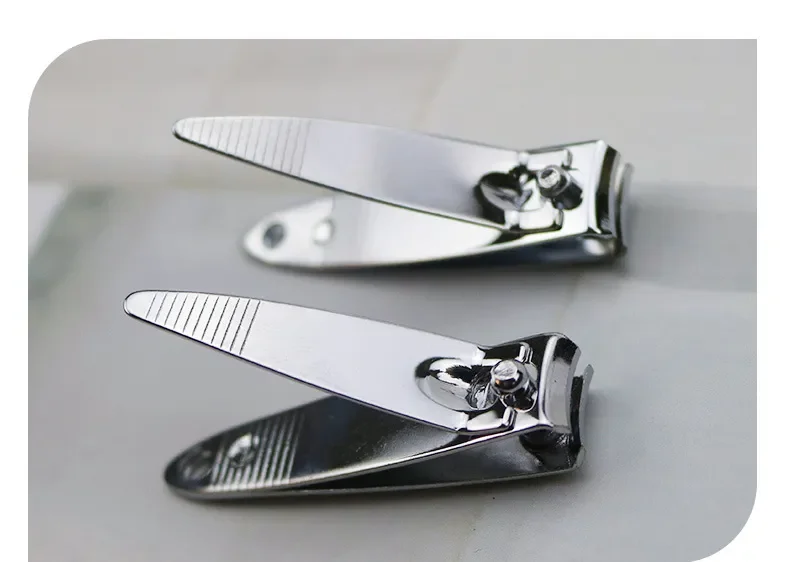
Nail care is an essential aspect of personal grooming that often goes unnoticed in our daily routines. While we may take our trusty nail clippers for granted, these simple yet ingenious tools have a fascinating history and a variety of features that can enhance our grooming experience. From their invention in the 19th century to the various designs available today, nail cutters have evolved significantly, reflecting changes in technology and personal care practices. In this blog post, we’ll explore 25 interesting facts about nail cutters that will not only inform you but also deepen your appreciation for this everyday tool. Whether you’re a nail care enthusiast or just someone looking to keep your nails in check, these insights will provide a fresh perspective on the humble nail clipper. Let’s dive in!
Invention in the 19th Century: The first nail clippers were invented in the 19th century, a period marked by significant advancements in personal grooming tools. Before the invention of nail clippers, people primarily used rudimentary tools like knives or scissors to manage their nails, which were often less effective and more dangerous. The development of the nail clipper introduced a safer and more efficient way to trim nails, leading to its widespread adoption in households and salons.
Alternate Names: Nail clippers are commonly referred to as nail nippers or nail scissors. The term “nipper” often refers to a specific type of nail clipper that features a lever mechanism for cutting, while “nail scissors” can describe a more traditional scissor-like tool used for nail trimming. The variety of names reflects the different designs and functionalities available in the market, catering to various preferences and needs.
Trimming Frequency: The average person trims their nails every 1-2 weeks, depending on individual nail growth rates and personal grooming habits. Factors such as age, diet, and health can influence nail growth. Regular trimming is essential not only for aesthetic purposes but also for maintaining nail health and hygiene, preventing issues such as hangnails or nail breakage.
Material Composition: Nail clippers are typically made from stainless steel, which is chosen for its durability and resistance to rust and corrosion. Stainless steel is an alloy that combines iron with chromium, providing strength and longevity. This material is ideal for personal grooming tools, as it can withstand the wear and tear of regular use while remaining hygienic and easy to clean.
Lever Mechanism Design: The design of nail clippers incorporates a lever mechanism that provides leverage for cutting nails. This mechanism allows users to apply minimal force while achieving a clean cut, making the process easier and safer. The lever action is engineered to maximize efficiency, reducing the risk of accidentally injuring oneself while trimming nails.
First Patent: The first patent for a nail clipper was issued in 1875, marking a significant milestone in the evolution of personal grooming tools. This patent formalized the design and functionality of nail clippers, paving the way for mass production and widespread availability. The innovation represented a shift towards more specialized tools for personal care, reflecting changing societal attitudes towards grooming.
Size Variations: Nail clippers come in various sizes, including those specifically designed for infants. These smaller clippers often feature rounded edges to prevent accidental cuts and are designed to accommodate the delicate nature of a baby’s nails. The availability of different sizes ensures that individuals can choose the most suitable tool for their specific needs, from adults to children and even pets.
Personal Grooming Tool: The nail clipper is considered a personal grooming tool, essential for maintaining nail hygiene and appearance. Regular nail trimming is associated with overall cleanliness and self-care, contributing to a polished appearance. The importance of nail care is emphasized in many cultures, where well-groomed nails are often seen as a reflection of personal hygiene and attention to detail.
Cutting Edge Design: The cutting edge of a nail clipper is usually angled to allow for a clean cut. This design feature is crucial for effectively trimming nails without causing splits or tears. The angle helps direct the force applied by the user, ensuring that the nail is cut smoothly and evenly. This attention to design enhances the user experience and promotes better nail health.
Usage for Fingernails and Toenails: Nail clippers can be used for both fingernails and toenails, although larger clippers are recommended for toenails due to their thickness and strength. Using the appropriate size of clipper ensures a safer and more effective trimming process. Some clippers are specifically designed for toenails, featuring wider jaws and sturdier construction to accommodate the unique needs of toenail care.
Built-in Nail Files: Some nail clippers come with built-in nail files for added convenience. These dual-function tools allow users to trim and then smooth the edges of their nails in one step, eliminating the need for a separate file. The inclusion of a nail file can enhance the grooming experience by providing a complete solution for nail care, making it easier to achieve a polished look without additional tools.
Nail Growth Rate: The average human nail grows about 1/8 inch (3 mm) per month. This growth rate can vary based on factors such as age, health, and diet. Younger individuals typically experience faster nail growth compared to older adults. Understanding the growth rate can help individuals plan their nail trimming schedule to maintain neat and healthy nails.
Variety of Styles: Nail clippers are available in various styles, including straight and curved edges. The choice between these styles often depends on personal preference and the shape of the nails. Straight-edge clippers are ideal for achieving a clean cut across the nail, while curved-edge clippers can help create a more rounded appearance. This variety allows users to select tools that best suit their grooming needs.
Electric Nail Clippers: The first electric nail clippers were introduced in the 1960s, representing a technological advancement in personal grooming. These devices often feature a motorized cutting mechanism that can make the trimming process faster and more efficient. Electric nail clippers are particularly beneficial for individuals with limited dexterity, as they require less manual effort compared to traditional clippers.
Metal and Plastic Components: Nail clippers are often made with a combination of metal and plastic components. The cutting edges are typically crafted from stainless steel for durability, while the handles may incorporate plastic for a lightweight and comfortable grip. This combination of materials helps balance strength and usability, ensuring that the clippers are both effective and easy to handle.
Cultural Importance: In some cultures, nail care is considered an important part of personal hygiene. Grooming practices, including nail trimming, can vary widely across different societies, with some cultures placing a strong emphasis on the appearance of nails as a reflection of one’s overall cleanliness and social status. This cultural significance highlights the role of nail care in personal presentation and societal norms.
Bacteria Harboring: Nail clippers can harbor bacteria if not cleaned regularly. The small crevices and edges of the clippers can trap debris and moisture, creating an environment for bacterial growth. It is recommended to clean nail clippers after each use, either by wiping them down with alcohol or washing them with soap and water, to maintain hygiene and prevent infections.
Guinness World Record: The Guinness World Record for the longest fingernails on a pair of hands was 28 feet 4.5 inches (8.65 meters). This record highlights the extremes of nail growth and care, showcasing individuals who prioritize nail length as a form of personal expression. However, maintaining such long nails requires significant effort and specialized grooming tools, including oversized nail clippers.
Price Range: Nail clippers can vary in price from a few dollars to over $100 for designer brands. The price often reflects the quality of materials, design, and brand reputation. While more affordable options can be effective for everyday use, higher-end brands may offer features such as ergonomic designs or specialized cutting mechanisms that enhance the user experience.
Ergonomic Handles: Some nail clippers are designed with ergonomic handles for better grip. These designs take into account the natural shape of the hand and the way force is applied during use, making them more comfortable and easier to operate. Ergonomic features can be particularly beneficial for individuals with arthritis or limited hand strength, allowing for a more enjoyable grooming experience.
Trimming Hangnails and Cuticle Edges: Nail clippers can be used to trim hangnails and cuticle edges, which are common issues that can arise with nail care. Hangnails occur when the skin around the nail splits or tears, and using nail clippers to trim them can help prevent further tearing and discomfort. Additionally, carefully cutting excess cuticle can enhance the appearance of the nail and promote healthier growth. However, it’s essential to use nail clippers cautiously in these areas to avoid injury.
Average Lifespan: The average lifespan of a nail clipper is about 5-10 years with regular use. The durability of nail clippers can be influenced by the quality of materials and how well they are maintained. Regular cleaning and proper storage can extend their lifespan, while neglecting maintenance can lead to rust or dull cutting edges, necessitating replacement sooner. Investing in a high-quality clipper can also contribute to longevity.
Salon Origins: Nail clippers were originally designed for use in salons before becoming common household items. In the early days, professional groomers relied on specialized tools to provide manicures and pedicures. As personal grooming became more popular and accessible, nail clippers transitioned into everyday use, allowing individuals to maintain their nails at home without needing to visit a salon regularly.
Specialized Pet Nail Clippers: Specialized nail clippers are available for pets, particularly for dogs and cats. These clippers are designed with safety features and ergonomic handles to accommodate the unique anatomy of animal nails. Pet nail clippers often come in various styles, including guillotine and scissors types, to suit different pet sizes and nail thicknesses, making it easier for pet owners to care for their furry friends’ nails safely.
Historical Evidence: The concept of nail clipping dates back thousands of years, with evidence found in ancient Egyptian artifacts. Archaeological findings suggest that ancient Egyptians used various tools for nail care, including rudimentary clippers and files made from materials like bronze. This historical context highlights the long-standing importance of nail grooming across cultures and time periods, emphasizing that nail care has been a part of personal hygiene for millennia.
FAQs about Nail Cutters
1. What are the different types of nail cutters?
- Nail clippers: These are the most common type, with two hinged blades that come together to cut nails. They come in various sizes and shapes, including straight, curved, and angled blades.
- Nail nippers: These have a small, sharp cutting edge that is ideal for trimming thick or ingrown nails. They are often used by professionals and people with nail problems.
- Baby nail clippers: These are designed for delicate baby nails and have rounded edges to prevent injuries.
- Electric nail clippers: These use a motorized blade to cut nails, making it easier for people with limited mobility or strength.
- Pet nail clippers: These are specifically designed for trimming pet nails and have a safety guard to prevent cutting too deeply.
2. How to choose the right nail cutter?
- Nail type: Consider the thickness and shape of your nails. For thick or ingrown nails, nippers might be better. For delicate nails, baby clippers or rounded-edge clippers are recommended.
- Ease of use: If you have limited mobility or strength, electric clippers might be a good option.
- Preference: Some people prefer the feel and control of manual clippers, while others find electric clippers more convenient.
3. How to properly use nail cutters?
- Cut straight across: Avoid cutting too short, as this can lead to ingrown nails.
- File the edges: Use a nail file to smooth the edges of your nails and prevent them from catching on things.
- Clean and disinfect: Regularly clean and disinfect your nail cutters to prevent the spread of germs.
4. How to prevent ingrown nails?
- Cut straight across: Avoid rounding the corners of your nails, as this can increase the risk of ingrown nails.
- Wear proper shoes: Make sure your shoes fit well and don’t squeeze your toes together.
- Avoid excessive soaking: Soaking your feet for too long can soften the skin and make it more susceptible to ingrown nails.
5. When to see a doctor about nail problems?
- Ingrown nails: If you have an ingrown nail that is causing pain or infection, see a doctor.
- Nail fungus: If you have a fungal infection of the nails, a doctor can prescribe medication.
- Nail trauma: If you have suffered a nail injury, such as a broken or discolored nail, consult a doctor.
6. Can you use nail cutters on other parts of the body?
- No. Nail cutters are designed for trimming nails and should not be used on other parts of the body. Using them on other areas can lead to cuts, infections, or other injuries.








